Page 63 of 611

542007 TUNDRA from Jul. ’07 Prod. (OM34463U)
3. SEATBACK ANGLE ADJUSTINGSWITCH
Move the control switch in the de-
sired direction.
Releasing the switch will stop the seat-
back at that position.
CAUTION
Avoid reclining the seatback any
more than needed. The seat belts pro-
vide maximum protection in a frontal
or rear collision when the driver and
the front passenger are sitting up
straight and well back in the seats. If
you are reclined, the lap belt may
slide past your hips and apply re-
straint forces directly to the abdomen
or your neck may contact the shoul-
der belt. In the event of a frontal
collision, the more the seat is re-
clined, the greater the risk of death
or serious injury.
4. SEAT LUMBER SUPPORT ADJUSTINGSWITCH
Push the switch on either side.
The amount of lumbar support will
change while the switch is pushed.
XS13209
BEFORE FOLDING FRONT
PASSENGER’S SEAT
1. Push the seat belt hanger down as far as it will go when it is in the
raised position.
XS13160
2. Make sure the shoulder belt passesthrough the hanger when folding the
front passenger ’s seat.
This prevents the shoulder belt from being
damaged.
CAUTION
The seat belt must be removed from
the hanger when the seat belt is in
use.
—Folding front passenger ’s
seat (Regular cab models)
Page 67 of 611

582007 TUNDRA from Jul. ’07 Prod. (OM34463U)
CAUTION
�Do not adjust the seat while the
vehicle is moving.
�Be careful that the seat does not
hit a passenger or luggage.
�Be careful not to get your hands or
feet pinched in the seat.
�After adjusting the seat position, re-
lease the lever and try sliding the
seat forward and backward to make
sure it is locked in position.
�After adjusting the seatback, push
your body back against the seat to
make sure the seat is locked in
position.
�When returning the seatback to the
upright position, observe the follow-
ing precautions in order to prevent
personal injury in a collision or
sudden stop:
Make sure the seatback is securely
locked by pushing forward and rear-
ward on the top of the seatback.
Failure to do so will prevent the
seat belt from operating properly.
Make sure the seat belts are not
twisted or caught in the seatback
and are arranged in their proper
position and are ready to use.
Folding down the rear seatbacks will en-
large the luggage compartment. See
“—Stowage precautions” on page 464 in
Section 2 for precautions when loading
luggage.
XS13158
Rear seats—
—Rear seat precautions—Adjusting rear seats
( C rew Max mo d els)
Page 68 of 611

592007 TUNDRA from Jul. ’07 Prod. (OM34463U)
1. SEAT POSITION ADJUSTING LEVERS
Hold the center of the lever and pull it
up. Then slide the seat to the desired
position with slight body pressure and
release the lever.
2. SEATBACK ANGLE ADJUSTING LEVERS
Pull the lever up. Then lean back to the
desired angle and release the lever.
CAUTION
�Do not adjust the seat while the
vehicle is moving.
�Be careful that the seat does not
hit a passenger or luggage.
�Avoid reclining the seatback any
more than needed. The seat belts
provide maximum protection in a
frontal or rear collision when the
passengers are sitting up straight
and well back in the seats. If you
are reclined, the lap belt may slide
past your hips and apply restraint
forces directly to the abdomen or
your neck may contact the shoulder
belt. In the event of a frontal colli-
sion, the more the seat is reclined,
the greater the risk of death or se-
rious injury.
�After adjusting the seat position, re-
lease the lever and try sliding the
seat forward and backward to make
sure it is locked in position.
�After adjusting the seatback, push
your body back against the seat to
make sure the seat is locked in
position.
NOTICE
Do not fold the rear seat seatback
forward with the luggage cover hooks
attached.
XS13146b
BEFORE RAISING REAR SEAT CUSHION 1. Stow the rear seat belt buckles as shown in the illustration.
This prevents the seat belt buckles from
falling out when you fold the seatback.
NOTICE
The seat belt and buckles must be
stowed before you raise the rear
seats cushion.
—Raising rear seat cushion
(Double cab models)
Page 69 of 611

602007 TUNDRA from Jul. ’07 Prod. (OM34463U)
XS13122
2. Make sure the shoulder belt passesthrough the hanger when folding the
rear seat.
This prevents the shoulder belt from being
damaged.
CAUTION
The seat belt must be removed from
the hanger when the seat belt is in
use.
XS13007
3. Raising rear seat cushion.
Pull the lever on the side of the bottom
cushion and lift up the cushion until it
locks.
When returning the rear seat, pull the le-
ver on the back of the bottom cushion
and pull the cushion downward until it
locks.
Folding down the rear seats will enlarge
the luggage compartment. See “—Stowage
precautions” on page 464 in Section 2 for
precautions when loading luggage.
NOTICE
To prevent damage to the box under
the seat, do not sit on the box when
the bottom cushion is in the raised
position.
CAUTION
When returning seats to their original
position, observe the following pre-
cautions in order to prevent death or
serious injury in a collision or sud-
den stop:
�Make sure the bottom cushion is
securely locked by trying to pull up
the edge of the bottom cushion.
Failure to do so will prevent the
seat belt from operation properly.
�Make sure the seat belts are not
twisted or caught under the bottom
cushion and are arranged in their
proper position and are ready to
use.
Page 70 of 611
612007 TUNDRA from Jul. ’07 Prod. (OM34463U)
XS13157
BEFORE FOLDING DOWN REAR SEATS1. Stow the rear seat belt buckles as shown in the illustration.
This prevents the seat belt buckles from
falling out when you fold the seatback.
NOTICE
To prevent damage to the seat belt
buckles, the seat belt buckles must
be stowed before you fold the seat-
back.
XS13161
2. Make sure the shoulder belt passes through the hanger when folding the
rear seat.
This prevents the shoulder belt from being
damaged.
CAUTION
The seat belt must be removed from
the hanger when the seat belt is in
use.
XS13159
FOLDING DOWN REAR SEATS
Pull the seatback angle adjusting lever
to unlock the seatback and fold the
seatback down until it locks.
CAUTION
Be careful that the seat does not hit
a passenger or luggage.
NOTICE
Do not fold the rear seat seatback
forward with the luggage cover hooks
attached.
—Folding down rear seats
( C rew Max mo d els)
Page 71 of 611
622007 TUNDRA from Jul. ’07 Prod. (OM34463U)
Folding down the rear seats will enlarge
the luggage compartment. See “—Stowage
precautions” on page 464 in Section 2 for
precautions when loading luggage.CAUTION
When returning the seatback to the
upright position, observe the follow-
ing precautions in order to prevent
death or serious injury in a collision
or sudden stop:
�Make sure the seatback is securely
locked by pushing forward and rear-
ward on the top of the seatback.
Failure to do so will prevent the
seat belt from operating properly.
�Make sure the seat belts are not
twisted or caught in the seatback
and are arranged in their proper
position and are ready to use.
XS13008
Front separate seats
XS13152
Front separate seats (with seat heater)
Head restraints
Page 72 of 611

632007 TUNDRA from Jul. ’07 Prod. (OM34463U)
XS13009
Front bench seat
XS13010
Rear seats (Double cab models)
XS13196
Rear seats (Crew Max models)
For your safety and comfort, adjust the
head restraint before driving.
To raise: Pull it up.
To lower: Push it down while pressing the
lock release button.
Front separate seats (with seat heater)
only—
You can pull up or push down the head
restraint. You can also move the front
head restraint forward or backward. If
such adjustment is desired, pull or push
the base of the head restraint.Rear center head restraint and front cen-
ter head restraint (bench seats)—When an
occupant sits on the center position of the
rear seats (Double cab and Crew Max
models) or the front seats (bench seats),
always pull up the center head restraint to
the lock position.
The head restraint is most effective when
it is close to your head. Therefore, using
a cushion on the seatback is not recom-
mended.
CAUTION
�Adjust the center of the head re-
straint so that it is closest to the
top of your ears.
�After adjusting the head restraint,
make sure it is locked in position.
�Do not drive with the head re-
straints removed.
Page 74 of 611

652007 TUNDRA from Jul. ’07 Prod. (OM34463U)
NOTICE
�Do not put unevenly weighed ob-
jects on the seat and do not stick
sharp objects (needles, nails, etc.)
into the seat.
� When cleaning the seats, do not
use organic substances (paint thin-
ner, benzine, alcohol, gasoline,
etc.). They may damage the heater
and seat surface.
� To prevent the battery from being
discharged, turn the switch off
when the engine is not running.
Toyota strongly urges that the driver and
passengers in the vehicle be properly re-
strained at all times with the seat belts
provided. Failure to do so could increase
the chance of injury and/or the severity of
injury in accidents.
The seat belts provided for your vehicle
are designed for people of adult size,
large enough to properly wear them.
Child. Use a child restraint system ap-
propriate for the child until the child be-
comes large enough to properly wear the
vehicle’s seat belts. See “Child restraint”
on page 114 in this Section for details.
REGULAR CAB MODELS—
If a child is too large for a child restraint
system, the child should sit in the seat
and must be restrained using the vehicle’s
seat belt.
DOUBLE CAB AND CREW MAX
MODELS—
If a child is too large for a child restraint
system, the child s hould sit in the rear
seat and must be restrained using the
vehicle’s seat belt. According to accident
statistics, the child is safer when properly
restrained in the rear seat than in the
front seat. If a child must sit in the front seat, the
seat belts should be worn properly. If an
accident occurs and the seat belts are not
worn properly, the force of the rapid infla-
tion of the airbag may cause death or
serious injury to the child.
Do not allow any children to stand up or
kneel on either rear or front seats. An
unrestrained child could suffer serious in-
jury or death during emergency braking or
a collision. Also, do not let the child sit
on your lap. Holding a child in your arms
does not provide sufficient restraint.
Pregnant woman.
Toyota recommends the
use of a seat belt. Ask your doctor for
specific recommendations. The lap belt
should be worn securely and as low as
possible over the hips and not on the
waist.
Injured person. Toyota recommends the
use of a seat belt. Depending on the inju-
ry, first check with your doctor for specific
recommendations
Seat belts—
—Seat belt precautions